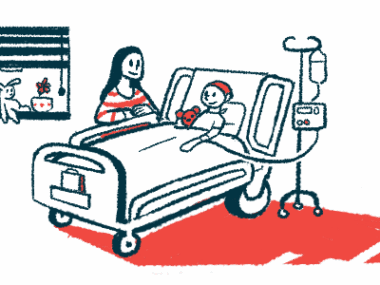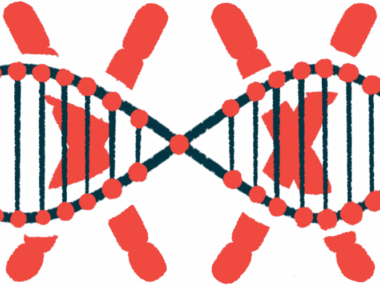Features of kEDS Appear in Girl With cEDS: Case Study
Diagnosis confirmed only after unreported COL5A2 gene variant discovered
Written by |

A young girl was diagnosed with the classical type of Ehlers–Danlos syndrome (EDS) despite showing signs of kyphoscoliotic EDS (kEDS), a case study reported.
Her diagnosis was confirmed only after the discovery of a previously unreported variant in the COL5A2 gene, known to be associated with classical EDS (cEDS).
The case expands the hallmark signs of classical EDS, illustrates the challenges to diagnosed EDS subtypes, and supports the use of multigene screening panels to confirm a diagnosis, the team noted.
The case study, “Classical Ehlers–Danlos syndrome with severe kyphoscoliosis due to a novel pathogenic variant of COL5A2,” was published in Clinical Case Reports.
Many variants that underlie EDS affect the production and function of collagen, the main protein in connective tissue that provides strength and structural integrity. Abnormal collagen results in weakened and fragile tissue, ultimately leading to EDS symptoms such as abnormally flexible joints and fragile skin.
Scoliosis, or the abnormal sideways curvature of the spine, is one of the most common features of EDS. Kyphosis, or the front-to-back spinal curvature that forms a hump, can also occur.
Kyphoscoliotic EDS combines scoliosis and kyphosis and is caused by variants in the PLOD1 or FKBP14 genes, both of which carry instructions for proteins that support collagen production.
Suspicion of kEDS
In this report, clinicians in France described the case of a young girl with severe congenital scoliosis (present at birth) and highly flexible joints, who was referred to an EDS center on suspicion of kEDS.
The girl was born with scoliosis and low muscle tone (hypotonia) following a normal pregnancy. A muscle biopsy ruled out muscle disease (myopathy). She wore a brace starting at 18 months to slow progression and walked independently at 2. Apart from difficulties holding a pen, her cognitive development and schooling progressed normally.
There was no history of sprains, fractures, or dislocations, but she had hypermobile joints, fragile skin, chronic knee and back pain, and anal fissures (small tissue tears). An eye exam revealed mild vision impairment and thinning to the cornea, the eye’s transparent, protective outer layer. Heart tests showed a type of heart valve disease. At age 5, clinicians suspected EDS.
At 9, she had spinal curvatures, a hump, bowed legs, a sunken chest, and flat feet, along with soft, translucent skin and bruising.
She had no other signs typically seen in cEDS patients, including stretchy skin (hyperextensibility), depressions in the skin caused by collagen loss (atrophic), small, hard movable nodules under the skin (subcutaneous spheroids), and fleshy lesions over the elbows and knees associated with scars (molluscoid pseudotumors).
“Considering criteria for cEDS, skin hyperextensibility and atrophic scarring are required for the diagnosis (major hallmarks), which the patient did not display during the clinical evaluation,” the researchers wrote.
Given the combination of severe and progressive kyphoscoliosis, low muscle tone, and hypermobile joints, a kEDS diagnosis was considered. Bracing and physiotherapy were applied to control scoliosis progression. Over time, however, she had chronic pain in her lower limbs, ongoing knee dislocations, bruising, moderate skin hyperflexibility, as well as heart and lung problems.
At 14, she had surgery to fuse her spinal bones to correct the scoliosis, which had progressed rapidly. Despite early treatment, her kyphoscoliosis was also complicated by lung disease, which reduced her lung function by about half, and led to at-home breathing (ventilation) support. At 15, she had a second fusion surgery to correct the scoliosis progression. She also benefited from follow-ups with heart and eye clinicians.
Gene analysis consistent with cEDS
Gene sequencing analysis using a multigene panel didn’t find variants in either PLOD1 and FKBP14 genes associated with kEDS. Instead, the researchers found a previously unreported variant in the COL5A2 gene, which encodes a component of the type 5 collagen protein and is known to cause cEDS.
The identified variant was c.3617G>A, wherein DNA code building block guanine (G) was changed to adenine (A). This variant, classified as pathogenic, or disease-causing, was not found in the parents’ DNA, suggesting it was a de novo variant, or a genetic mutation that occurred spontaneously during fetal development, the researchers noted.
The novel COL5A2 variant changed the collagen protein by substituting a glycine amino acid for a glutamate amino acid, both protein building blocks. Modeling of the protein’s structure showed the substitution of a smaller glycine for a larger glutamate amino acid would destabilize the collagen structure and impair its function, consistent with causing cEDS.
“Medical history of the patient was not totally in line with the usual form of cEDS related to COL5A2 or COL5A1, due to the lack of atrophic scarring,” the researchers wrote. “This case expands the phenotypic [charactistic] spectrum of cEDS and illustrates the challenge to diagnose EDS subtypes and underlines the relevance of using a multigene panel for confirming the diagnosis.”






